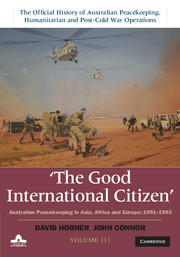Book contents
- Frontmatter
- Contents
- Maps
- Preface
- Chronology 1989–99
- Abbreviations
- Part 1 Strategy and policy
- Part 2 Cambodia
- 3 From Angkor Wat to Pol Pot
- 4 Law and order on the border
- 5 An Australian peace proposal
- 6 First into Phnom Penh
- 7 The roadblock
- 8 Change in plan
- 9 ‘Democracy's surprise triumph’
- 10 Developing Operation Banner
- 11 Winding up Operation Banner
- Part 3 Western Sahara
- Part 4 Former Yugoslavia
- Part 5 Watch on Iraq
- Appendix A United Nations Security Council resolutions
- Appendix B Major office bearers, 1991–99
- Bibliography
- Index
- Plate section
- References
11 - Winding up Operation Banner
The end of Australian military assistance to Cambodia, 1997–99
from Part 2 - Cambodia
Published online by Cambridge University Press: 12 May 2022
- Frontmatter
- Contents
- Maps
- Preface
- Chronology 1989–99
- Abbreviations
- Part 1 Strategy and policy
- Part 2 Cambodia
- 3 From Angkor Wat to Pol Pot
- 4 Law and order on the border
- 5 An Australian peace proposal
- 6 First into Phnom Penh
- 7 The roadblock
- 8 Change in plan
- 9 ‘Democracy's surprise triumph’
- 10 Developing Operation Banner
- 11 Winding up Operation Banner
- Part 3 Western Sahara
- Part 4 Former Yugoslavia
- Part 5 Watch on Iraq
- Appendix A United Nations Security Council resolutions
- Appendix B Major office bearers, 1991–99
- Bibliography
- Index
- Plate section
- References
Summary
Although Australia's military assistance projects in Cambodia had progressed satisfactorily and, in some cases, very well in the period between 1994 and 1997, they were always at the mercy of the fragile and precarious political situation that was evolving in the country after the 1993 elections. The political situation in Cambodia presented the Australian Government with a series of questions: how could Australia's assistance be justified if the Cambodian Government proved to be brutal and undemocratic? Were Australian government officials, including the members of the ADF, being placed in danger if they remained in Cambodia? At what point could it be seen that the Cambodians were able to manage the projects themselves and therefore allow the Australians to withdraw? What would be the international ramifications of withdrawing from such projects as humanitarian demining, in which Australia had played a leading role? Chapter 10 discussed some of these dilemmas. But events in 1997 were to demonstrate them to an even greater degree.
Political instability
The government's decisions about assistance were constantly made in the context of the changing political situation in Cambodia, and it was kept abreast of the situation by the frequent reports from its successive ambassadors and the defence attachés. Initially the threat from the Khmer Rouge forced the other factions to work together. But when the Khmer Rouge started to disintegrate during 1996, with many members defecting to the government, the enmity between the factions became more pronounced. Although Hun Sen's Cambodian People's Party (CPP) had won fewer votes than Prince Ranariddh's party Funcinpec, the CPP was more ruthless and adept at politics, having ruled Cambodia since the Vietnamese invasion in 1979, and gradually gained more power.
- Type
- Chapter
- Information
- The Good International CitizenAustralian Peacekeeping in Asia, Africa and Europe 1991–1993, pp. 250 - 264Publisher: Cambridge University PressPrint publication year: 2014

